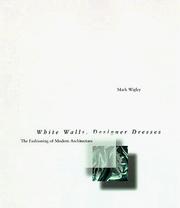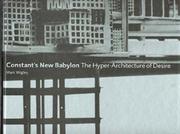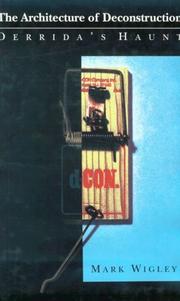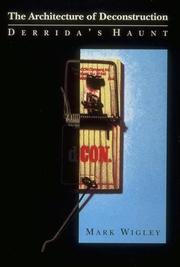| Listing 1 - 10 of 47 | << page >> |
Sort by
|

ISBN: 9780262231855 9780262731454 0262731452 0262231859 Year: 1995 Publisher: Cambridge (Mass.) : MIT press,
Abstract | Keywords | Export | Availability | Bookmark
 Loading...
Loading...Choose an application
- Reference Manager
- EndNote
- RefWorks (Direct export to RefWorks)
In a daring revisionist history of modern architecture, Mark Wigley opens up a new understanding of the historical avant-garde. He explores the most obvious, but least discussed, feature of modern architecture: white walls. Although the white wall exemplifies the stripping away of the decorative masquerade costumes worn by nineteenth-century buildings, Wigley argues that modern buildings are not naked. The white wall is itself a form of clothing-- the newly athletic body of the building, like that of its occupants, wears a new kind of garment and these garments are meant to match. Not only did almost all modern architects literally design dresses, Wigley points out, their arguments for a modern architecture were taken from the logic of clothing reform. Architecture was understood as a form of dress design. Wigley follows the trajectory of this key subtext by closely reading the statements and designs of most of the protagonists, demonstrating that it renders modern architecture's relationship with the psychosexual economy of fashion much more ambiguous than the architects' endlessly repeated rejections of fashion would suggest. Indeed, Wigley asserts, the very intensity of these rejections is a symptom of how deeply they are embedded in the world of clothing. By drawing on arguments about the relationship between clothing and architecture first formulated in the middle of the nineteenth century, modern architects in fact present ed a sophisticated theory of the surface, modernizing architecture by transforming the status of the surface. White Walls, Designer Dresses shows how this seemingly incidental clothing logic actually organizes the detailed design of the modern building, dictating a system of polychromy, understood as a multicolored outfit. The familiar image of modern architecture as white turns out to be the effect of a historiographical tradition that has worked hard to suppress the color of the surfaces of the buildings that it describes. Wigley analyzes this suppression in terms of the sexual logic that invariably accompanies discussions of clothing and color, recovering those sensuously colored surfaces and the extraordinary arguments about clothing that were used to defend them.
colors [hues or tints] --- kleuren --- Architecture --- hedendaagse architectuur --- White in architecture. --- Architecture, Modern --- Blanc en architecture --- 72.049 --- Architectuur verschillende onderwerpen --- History --- Architectuur en mode parallellen in ontwerpmetodiek --- Kleur in de architectuur 20ste eeuw witte wanden --- white [color] --- color theory --- Blanc dans l'architecture --- White in architecture --- Wit in de architectuur --- -White in architecture --- CDL --- 72.036 --- Modern architecture --- Architectuur en mode ; parallellen in ontwerpmetodiek --- Kleur in de architectuur ; 20ste eeuw ; witte wanden --- Architectuur ; verschillende onderwerpen --- Modern [style or period] --- architectural theory --- architecture [discipline] --- Art --- anno 1900-1999 --- anno 2000-2099 --- architecture [object genre] --- Architecture [Modern ] --- 20th century --- Architecture, Modern - 20th century

ISBN: 9064503435 Year: 1998 Publisher: Rotterdam : 010,
Abstract | Keywords | Export | Availability | Bookmark
 Loading...
Loading...Choose an application
- Reference Manager
- EndNote
- RefWorks (Direct export to RefWorks)
Architecture --- Constant --- City planning --- Urbanisme --- History --- Exhibitions. --- Philosophy --- Histoire --- Expositions --- Philosophie --- Constant, --- 72.01 --- 711.4 --- New Babylon --- Utopische architectuur --- Visionaire architectuur --- 711.427 --- 72.02 --- Nieuwenhuys Constant Anton --- Constant Anton Nieuwenhuys 1920-2005 (° Amsterdam, Nederland) --- Architectuur ; 1956-1974 ; Constant Nieuwenhuys --- Architectuur ; stedenbouw ; visionaire ; futuristische --- Architectuur en maatschappij --- Internationale Situationniste --- 72.07 --- (069) --- kunst --- twintigste eeuw --- Nederland --- Nieuwenhuys Constant --- Cobra --- kunst en architectuur --- utopie --- stedenbouw --- kunst en stedenbouw --- Debord Guy --- situationisme --- utopische architectuur --- 7.071 CONSTANT --- 72.071 CONSTAN --- Architectuurtheorie --- Architectuur (theorie) --- Stedenbouw --- Architectuuresthetica --- Architectuur (esthetica) --- Denkbeeldige steden --- Idealistische steden --- Utopia --- Utopische steden --- Architectuurtekeningen --- Architecten. Stedenbouwkundigen A - Z --- (Musea. Collecties) --- Cities and towns --- Civic planning --- Land use, Urban --- Model cities --- Redevelopment, Urban --- Slum clearance --- Town planning --- Urban design --- Urban development --- Urban planning --- Land use --- Planning --- Art, Municipal --- Civic improvement --- Regional planning --- Urban policy --- Urban renewal --- Government policy --- Management

ISBN: 0262231700 Year: 1993 Publisher: Cambridge (Mass.) : MIT press,
Abstract | Keywords | Export | Availability | Bookmark
 Loading...
Loading...Choose an application
- Reference Manager
- EndNote
- RefWorks (Direct export to RefWorks)
In this book Wigley redefines the question of deconstruction and architecture. By locating the architecture already hidden within deconstructive discourse, he opens up more radical possibilities for both architecture and deconstruction, offering a way of rethinking the institution of architecture while using architecture to rethink deconstructive discourse. Wigley relentlessly tracks the tacit argument about architecture embedded within Jacques Derrida's discourse, a curious line of argument that passes through each of the philosopher's texts. He argues that this seemingly tenuous thread actually binds those texts, acting as their source of strength but also their point of greatest weakness. Derrida's work is seen to render architecture at once more complex, uncanny, pervasive, unstable, brutal, enigmatic, and devious, if not insidious, while needing itself to be subjected to an architectural interrogation. Wigley provocatively turns Derrida's reading strategy back on his texts to expose the architectural dimension of their central notions like law, economy, writing, place, domestication, translation, vomit, spacing, laughter, and dance. Along the way he highlights new aspects of the relationship between Heidegger and Derrida, explores the structural role of ornament and the elusive architecture of haunting, while presenting a fascinating account of the institutional politics of architecture.
Deconstructivism (Architecture). --- 1 DERRIDA, JACQUES --- Deconstructivism (Architecture) --- 72.01 --- 1 --- Derrida, Jacques --- Deconstructivisme --- Mark Wigley --- architectuur --- twintigste eeuw --- architectuurtheorie --- deconstructie --- Derrida Jacques --- Architecture, Deconstructivist --- Deconstructionism (Architecture) --- Deconstructivist architecture --- Architecture, Modern --- 1 DERRIDA, JACQUES Filosofie. Psychologie--DERRIDA, JACQUES --- Filosofie. Psychologie--DERRIDA, JACQUES --- Architectuur (theorie) --- Architectuurtheorie --- Filosofie --- Philosophy. --- Derrida, Jacques. --- Derrida, J. --- Derida, Žak --- Derrida, Jackes --- Derrida, Zhak --- Deridah, Z'aḳ --- Deridā, Jāka --- Dirīdā, Jāk --- Деррида, Жак --- דרידה, ז'אק
Book
ISBN: 9783037784280 3037784288 Year: 2015 Publisher: Zurich : Lars Müller Publishers,
Abstract | Keywords | Export | Availability | Bookmark
 Loading...
Loading...Choose an application
- Reference Manager
- EndNote
- RefWorks (Direct export to RefWorks)
The real architecture of our world is that of electromagnetic frequencies. We are constantly being reshaped by countless overlapping waves that pulse through our buildings and bodies. Buckminster Fuller Inc.: Architecture in the Age of Radio extensively explores Richard Buckminster Fuller’s work and thought, shedding new light on the questions raised by our increasingly electronic world. The publication investigates Fuller’s multi-dimensional reflections on the architecture of radio and his idea that the real site of architecture is the electromagnetic spectrum. It draws on Fuller’s archive to follow his radical thinking from toilets to telepathy, plastic to prosthetics, nanostructures to networks, and deep data to deep space. Buckminster Fuller Inc. rethinks the legacy of one of the key protagonists of the twentieth century – a unique amalgam of theorist, designer and performance artist –and becomes a crucial reference point in trying to understand the development and impact of our electronic environment.
Engineering design. --- 72.07 --- 72.038 --- 72.01 --- Architectuur ; 20ste eeuw ; R. Buckminster Fuller --- Biografieën ; architecturale ; R. Buckminster Fuller --- Fuller, R. Buckminster 1895-1983 (°Milton, Massachusetts, Verenigde Staten) --- Design, Engineering --- Engineering --- Industrial design --- Strains and stresses --- Architecten. Stedenbouwkundigen A - Z --- Architectuurgeschiedenis ; 1950 - 2000 --- Architectuur ; theorie, filosofie, esthetica --- Design --- Fuller, R. Buckminster --- Fuller, Buckminster, --- Fuller, Bucky, --- Fuller, Richard Buckminster, --- Architecture --- Visionary architecture --- History --- Fuller, R. Buckminster, --- Engineering design --- Fuller, Richard Buckminster --- Fuller, Buckminster --- Fuller, Bucky --- Architecture visionnaire --- Histoire
Book
ISBN: 9783037784273 303778427X Year: 2018 Publisher: Zurich : Lars Müller Publishers,
Abstract | Keywords | Export | Availability | Bookmark
 Loading...
Loading...Choose an application
- Reference Manager
- EndNote
- RefWorks (Direct export to RefWorks)
Parmi les nombreux spectacles présentés dans la légendaire galerie 112 Greene Street - un épicentre artistique de la scène du centre-ville de New York dans les années 1970 - le spectacle du groupe Anarchitecture de mars 1974 a fait l'objet des discussions les plus persistantes, en dépit d'un manque total de documentation à ce sujet. L'anarchitecture est devenue un mythe fondateur, mais il reste à le comprendre correctement. Issue d'une série de réunions organisées par Gordon Matta-Clark et reflétant son intérêt de longue date pour l'architecture, l'exposition Anarchitecture a été conçue comme une déclaration de groupe anonyme composée de photographies sur l'intersection de l'art et du bâtiment. Mais est-ce vraiment arrivé? Il n'existe que par le biais de traces archivistiques obliques et de la mémoire des participants. Cutting Matta-Clark enquête sur le groupe Anarchitecture en tant que sorte de séminaire de recherche collectif, à travers des entretiens approfondis avec les protagonistes et un dossier de toutes les preuves disponibles. Le dossier comprend une collection de "cartes artistiques" aphoristiques de Matta-Clark, les 96 photographies produites par les différents participants pour une éventuelle inclusion dans l'exposition, ainsi que des images d'une vidéo récemment découverte du voyage en bus de Matta-Clark, désormais célèbre, pour voir Splitting à Englewood, New Jersey Of the many shows at the fabled 112 Greene Street gallery - an artistic epicenter of New York's downtown scene in the 1970s - the Anarchitecture group show of March 1974 has been the subject of the most enduring discussion, despite a complete lack of documentation about it. Anarchitecture has become a foundational myth, but one that remains to be properly understood. Stemming from a series of meetings organized by Gordon Matta-Clark and reflecting his long-standing interest in architecture, the Anarchitecture exhibition was conceived as an anonymous group statement in photographs about the intersection of art and building. But did it actually happen? It exists only through oblique archival traces and the memories of the participants. Cutting Matta-Clark investigates the Anarchitecture group as a kind of collective research seminar, through extensive interviews with the protagonists and a dossierof all the available evidence. The dossier includes a collection of Matta-Clark's aphoristic 'art cards', the 96 photographs that were produced by the various participants for possible inclusion in the exhibition, and images from a recently unearthed video of Matta-Clark's now famous bus trip to see Splitting in Englewood, New Jersey
investigation --- architectural criticism --- Matta-Clark, Gordon --- Anarchitecture Group [New York, N.Y.] --- Art and architecture --- 7.07 --- Architecture and art --- Architecture --- Kunstenaars met verschillende disciplines, niet traditioneel klasseerbare, conceptuele kunstenaars A - Z --- Matta-Clark, Gordon, --- Clark, Gordon Matta-, --- Criticism and interpretation. --- 7.038 --- Anarchitectuur --- Kunst en architectuur ; ingrepen ; G. Matta-Clark --- Architectuur-sculpturen ; insnijdingen --- Situationisme --- Process Art --- Matta-Clark, Gordon 1945-1978 (°New York, Verenigde Staten). Gestorven te Antwerpen --- Kunstgeschiedenis ; 1950 - 2000 --- 112 Greene Street (Gallery) --- History. --- Matta-Clark, Gorden --- Matta-Clark, G. --- Group work in art --- Art et architecture --- Art --- History --- Histoire --- Travail en équipe --- Architecture et arts --- Matta-Clark, Gordon (1943-1978) --- Art and architecture - United States - 20th century --- Artists - United States - 20th century - Interviews --- Déconstructivisme --- Rapport art-architecture --- Situationnisme --- An-esthetisme --- An-architecture --- Matta-Clark, Gordon, - 1943-1978 - Criticism and interpretation --- Matta-clark, Gordon
Book
ISBN: 0262286203 0585003343 9780585003344 9780262286206 Year: 1993 Publisher: Cambridge, Mass. MIT Press
Abstract | Keywords | Export | Availability | Bookmark
 Loading...
Loading...Choose an application
- Reference Manager
- EndNote
- RefWorks (Direct export to RefWorks)
In this book Wigley redefines the question of deconstruction and architecture. By locating the architecture already hidden within deconstructive discourse, he opens up more radical possibilities for both architecture and deconstruction, offering a way of rethinking the institution of architecture while using architecture to rethink deconstructive discourse. Wigley relentlessly tracks the tacit argument about architecture embedded within Jacques Derrida's discourse, a curious line of argument that passes through each of the philosopher's texts. He argues that this seemingly tenuous thread actually binds those texts, acting as their source of strength but also their point of greatest weakness. Derrida's work is seen to render architecture at once more complex, uncanny, pervasive, unstable, brutal, enigmatic, and devious, if not insidious, while needing itself to be subjected to an architectural interrogation. Wigley provocatively turns Derrida's reading strategy back on his texts to expose the architectural dimension of their central notions like law, economy, writing, place, domestication, translation, vomit, spacing, laughter, and dance. Along the way he highlights new aspects of the relationship between Heidegger and Derrida, explores the structural role of ornament and the elusive architecture of haunting, while presenting a fascinating account of the institutional politics of architecture.
Deconstruction (Architecture) --- Deconstructivism (Architecture) --- Architecture --- Art, Architecture & Applied Arts --- Architecture, Deconstructivist --- Deconstructionism (Architecture) --- Deconstructivist architecture --- Architecture, Modern --- Philosophy. --- Derrida, Jacques --- Derrida, Jacques. --- Derrida, J. --- Derida, Žak --- Derrida, Jackes --- Derrida, Zhak --- Deridah, Z'aḳ --- Deridā, Jāka --- Dirīdā, Jāk --- Деррида, Жак --- דרידה, ז'אק

ISBN: 0262731142 Year: 1995 Publisher: Cambridge, Mass. : MIT Press,
Abstract | Keywords | Export | Availability | Bookmark
 Loading...
Loading...Choose an application
- Reference Manager
- EndNote
- RefWorks (Direct export to RefWorks)
Book
ISBN: 087070298X Year: 1988 Publisher: New York, N.Y. Museum of Modern art
Abstract | Keywords | Export | Availability | Bookmark
 Loading...
Loading...Choose an application
- Reference Manager
- EndNote
- RefWorks (Direct export to RefWorks)
architecture [discipline] --- Deconstructivist --- Architecture --- anno 1900-1999 --- Constructivism (Architecture) --- Deconstructivism (Architecture) --- Constructivisme (Architecture) --- Déconstructivisme (Architecture) --- Influence --- Exhibitions --- Expositions --- -Architecture, Modern --- -Constructivism (Architecture) --- Modern architecture --- Architecture, Deconstructivist --- Deconstructionism (Architecture) --- Deconstructivist architecture --- Architecture, Modern --- -Exhibitions --- Déconstructivisme (Architecture) --- Architectuur --- architectuur [vakgebied] --- deconstructivisme
Book
ISBN: 9783037785119 303778511X Year: 2016 Publisher: Zürich, Switzerland : Lars Müller Publishers,
Abstract | Keywords | Export | Availability | Bookmark
 Loading...
Loading...Choose an application
- Reference Manager
- EndNote
- RefWorks (Direct export to RefWorks)
The question "are we human?" is both urgent and ancient. Beatriz Colomina and Mark Wigley offer a multi-layered exploration of the intimate relationship between human and design. Their field notes offer an archaeology of the way design has gone viral and is now bigger than the world. They range across the last few hundred thousand years and the last few seconds to scrutinize the uniquely plastic relation between brain and artifact. A vivid portrait emerges. Design becomes the way humans ask questions and thereby continuously redesign themselves.
Design. --- Design --- Philosophy. --- kunst --- kunsttheorie --- designtheorie --- 130.2 --- Istanbul design biennial --- cultuurfilosofie --- 766.01 --- productdesign --- 7.01 --- 745.01 --- design --- 749.01 --- Verhouding mens en design --- Meubelkunst en design ; theorie, filosofie, esthetica --- 770.6 --- productdesign ; geschiedenis --- productdesign, filosofie, esthetiek en kritiek --- Histoire du design --- Philosophy --- Philosophie --- 13 --- 21ste eeuw (architectuur) --- Cultuurfilosofie --- Kunst (theorie) --- Kunsttheorie --- Design - Philosophy --- Product strategy --- History of civilization
Book
ISBN: 9782884741446 2884741445 Year: 2008 Publisher: Gollion: Infolio,
Abstract | Keywords | Export | Availability | Bookmark
 Loading...
Loading...Choose an application
- Reference Manager
- EndNote
- RefWorks (Direct export to RefWorks)
"À partir de la dernière version de Dymaxion House, concept de maison circulaire et métallique développé entre 1929 et 1946, l'auteur Federico Neder, spécialiste de l'histoire de la domesticité et des "machines à habiter" du XXè siècle, explore à travers une série d'histoires entrecroisées, la spatialité conflictuelle du prototype de Fuller. Il traque ses transformations successives qui font émerger un univers déroutant où se croisent des véhicules, du mobilier, des vêtements, des appareils ménagers. D'autres exemples de maisons "plus célèbres" sont invitées à participer à un dialogue imaginaire au cours duquel l'auteur montre comment les visions de Fuller ont dépassé les frontières de la carapace scintillante de ses prototypes, anticipant des changements d'ordre technologique, social et même culturel de l'art d'habiter des XXe et XXIe siècles."(éd.)
Prototype --- Architecture mobile --- Plan circulaire --- Maison individuelle --- Buckminster Fuller, Richard --- Utopies architecturales --- Habitations individuelles --- Fuller, Richard Buckminster --- Engineering design. --- Conception technique --- Architecture, Domestic. --- Architecture domestique --- Dwellings. --- Habitations --- Fuller, R. Buckminster --- Fuller, Richard Buckminster, --- Fuller, Richard Buckminster, 1895-1983
| Listing 1 - 10 of 47 | << page >> |
Sort by
|

 Search
Search Feedback
Feedback About UniCat
About UniCat  Help
Help News
News